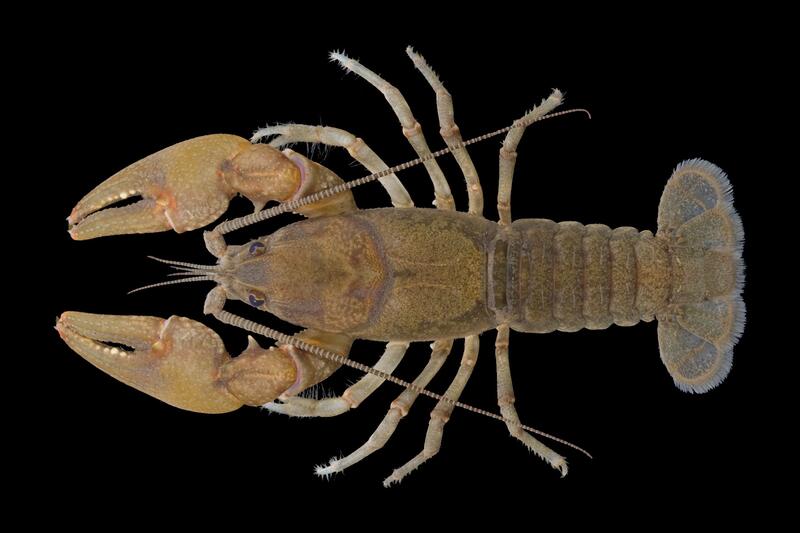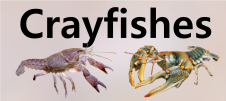







Loading profile. Please wait . . .
Cambarus bartonii (Fabricius, 1798)
Common Crayfish




Federal Protection: No US federal protection
State Protection: No Georgia state protection
Global Rank: G5
State Rank: S5
Element Locations Tracked in Biotics: No
SWAP 2015 Species of Greatest Conservation Need (SGCN): No
SWAP 2025 Species of Greatest Conservation Need (SGCN): No
2025 SGCN Priority Tier: None
Element Occurrences (EOs) in Georgia: 0
Habitat Summary for element in Georgia: Associated with rocks or woody debris in all areas of small streams, occasionally burrows in banks
The Common Crayfish is probably one of the most variable in North America. The overall color of this species can vary from tan to dark brown or olive with darker blotches. In some populations the rear margins of the abdominal segments can be reddish. The tips of the fingers may be orangish. Usually with a single row of flattened tubercles along the mesial margin of the palm (rarely two rows). The areola is wide and the rostrum is typically short and wide with no marginal spines or tubercles. This species reaches a maximum total body length of about 100 mm (3.9 in).
In Georgia the Common Crayfish is most likely to be confused with the Little Tennessee Crayfish, Cambarus georgiae; Hiwassee Crayfish, C. hiwasseensis; and Hiwassee Headwater Crayfish, C. parrishi. The claws of both the Hiwassee Crayfish and Hiwassee Headwater Crayfish have two rows of tubercles along the mesial margin of the palm, while those of Common Crayfish typically have a single row. The Little Tennessee Crayfish has marginal spines on the rostrum and a well-developed cervical spine; the Common Crayfish possesses neither characteristic.
The Common Crayfish inhabits nearly all areas of small streams including flowing areas and pools. It is typically found beneath rocks or woody debris, but will also tunnel in, or along the banks of streams among rocks or under logs.
No studies of the Common Crayfish are known. Crayfishes are considered opportunistic omnivores and likely feed on live and decaying vegetation, aquatic insect larvae, small fishes, and dead animal matter.
Stream dwelling crayfishes typically hide during the day and come out at night to feed. Reproduction usually occurs during the spring and fall, but males in reproductive condition may be found at any time during the year. When female crayfish are ready to lay eggs, they usually find a secure hiding place and hence are rarely encountered. When the eggs are released, the female attaches them to her swimmerets and is said to be "in berry." Upon hatching, the juvenile crayfish are attached to the mother by a thread. After the juveniles molt for the second time, they are free of the mother, but stay close and will hold on to her for some time. Eventually they move off on their own. Crayfishes molt 6 or 7 times during their first year of life and most are probably able to reproduce by the end of that year. They molt once or twice a year for the remainder of their lives and live about 3 years. Male Common Crayfish in reproductive condition have been collected in all months except December, January, and February. Several females with eggs were collected in April and June and a single female with young was found in August. The smallest breeding male known is about 40 mm (1.6 in) and the smallest female with eggs is about 38 mm (1.5 in) in length (Hobbs 1981).
Flipping larger rocks in just about any habitat in a stream should turn up this species. The animal can be pinned by hand or gently driven into a dipnet. Using a backpack electroshocker or baited minnow traps set overnight are effective as well. Excavating burrows along banks may also yield specimens.
The Common Crayfish is most commonly found in the Blue Ridge physiographic province from northeastern Georgia to Quebec, Canada. In Georgia it primarily inhabits upland streams in the north-central and northeastern portion of the state in the Hiwassee, Chattahoochee, Little Tennessee, and Savannah drainages. There are a few records from the upper Conasauga and Etowah river systems, widely scattered populations in the upper Oconee and Broad river systems, and a single record from the Little River in Wilkes County (Eversole and Jones 2004; Hobbs 1981, 1989). A subspecies of Common Crayfish (Appalachian Brook Crayfish, Cambarus bartonii cavatus) has historically been recognized by some researchers; this form is found in northwestern Georgia, eastern Tennessee and Kentucky, western Virginia and West Virginia, and Ohio (Hobbs 1981, 1989).
Heavy sedimentation resulting from poor development and land management practices may cover substrates and other daytime hiding places on which crayfishes rely to avoid predation. The introduction of non-native crayfishes is a threat to all native crayfishes.
This species is widespread and common and apparently stable in Georgia.
Conserving populations of the Common Crayfish will require general watershed level protection measures, including the protection of riparian zones, control of sediment and nutrient runoff from farms and construction sites, and limiting the amount of impervious cover (e.g., pavement) within occupied watersheds. Non-native crayfishes should never be used for bait; instead, anglers should use crayfishes collected from the river system where they will be fishing. Unused bait of any kind should not be released back into Georgia waters.
Eversole, A.G. and D.R. Jones. 2004. Key to the Crayfish of South Carolina. US Forest Service Publication. 79 pp.
Hobbs, H.H., Jr. 1981. The crayfishes of Georgia. Smithsonian Contributions to Zoology 318:1–549.
Hobbs, H.H., Jr. 1989. An illustrated checklist of the American crayfishes (Decapoda: Astacidae, Cambaridae, and Parastacidae). Smithsonian Contributions to Zoology 480:1–236.
Taylor, C.A., G.A. Schuster, J.E. Cooper, R.J. DiStefano, A.G. Eversole, P. Hamr, H.H. Hobbs III, H.W. Robison, C.E. Skelton, and R.F. Thoma. 2007. A reassessment of the conservation status of crayfishes of the United States and Canada after 10+ years of increased awareness. Fisheries 32:372–389.
Christopher E. Skelton
C. Skelton, 2012: original account
C. Skelton, February 2019: general update of account.